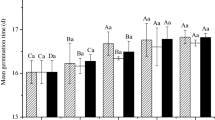Abstract
Chromatographic procedures were used to isolate inhibitors of seed germination from sweet potato root periderm tissue. The inhibitory activity of all fractions was monitored using a proso millet seed germination bioassay. A single HPLC peak, representing approximately 1.2% of the periderm dry weight, accounted for most of the inhibitory activity. The active fraction was labile in methanolic solution. Further fractionation of this peak by HPLC methods was not successful. In vitro seed germination dose-response relationships were established for the peak. The various seed species exhibited an extremely wide range of sensitivity. The I50 values were 0.16, 0.013 and 0.011 mg/ml for redroot pigweed, velvetleaf, and proso millet, respectively. Tall morning glory was not inhibited by any concentration tested.
Similar content being viewed by others
References
Alsaadawi, I.S., Al-Uqaili, J.K., Alrubeea, A.J., andAl-Hadithy, S.M. 1986. Allelopathic suppression of weed and nitrification by selected cultivars ofSorghum bicolor (L.) Moench.J. Chem. Ecol. 12:209–219.
Anaya, A.L., Calera, M.R., Mata, R., andPereda-Miranda, R. 1990. Allelopathic potential of compounds isolated fromIpomoea tricolor Cav. (Convolvulaceae).J. Chem. Ecol. 16:2145–2152.
Barnes, J.P., andPutman, A.R. 1983. Rye residues contribute to weed suppression in no-tillage cropping systems.J. Chem. Ecol. 9:1045–1057.
Barnes, J.P., andPutman, A.R. 1986. Evidence for allelopathy by residues and aqueous extracts of rye (Secale cereale).Weed Sci. 34:384–390.
Fay, P.K., andDuke, W.B. 1977. An assessment of allelopathic potential inAvena germplasm.Weed Sci. 25:244–228.
Finney, D.J. 1971. Probit Analysis. Cambridge Press, London, pp. 10–49.
Guenzi, W.D., andMcCalla, T.M. 1966. Phenolic acids in oats, wheat, sorghum and corn residues and their phytotoxicity.Agron. J. 58:303–304.
Hall, A.B., Blum, U., andFites, R.C. 1983. Stress modification of allelopathy ofHelianthus annuus L. debris on seedling biomass production ofAmaranthus retroflexus L.J. Chem. Ecol. 9:1213–1222.
Harrison, H.F., Jr. andPeterson, J.K. 1986. Allelopathic effects of sweetpotatoes (Ipomoea batatas) on yellow nutsedge (Cyperus esculentus) and alfalfa (Medicago sativa)Weed Sci. 34:623–627.
Harrison, H.F.,Jr. andPeterson, J.K. 1991. Evidence that sweetpotatoes (Ipomoea batatas) are allelopathic to yellow nutsedge (Cyperus esculentus). Weed Sci. (In press).
Huber, D.M., andAbney, T.S. 1986. Soybean allelopathy and subsequent cropping.J. Agron. Crop Sci. 157:73–78.
Hyodo, H., Uritani, I., andAkai, S. 1969. Production of furanoterpenoids and other compounds in sweet potato root tissue in response to infection by various isolates ofCeratocystis fimbriata.Phytopathol. Z. 65:332–340.
Leather, G.R. 1983. Sunflowers (Helianthus annuus) are allelopathic to weeds.Weed Sci. 31:37–42.
Lockerman, R.H., andPutman, A.R. 1979. Evaluation of allelopathic cucumbers (Cucumis sativus) as an aid to weed control.Weed Sci. 27:54–57.
Lockerman, R.H., andPutman, A.R. 1981. Growth inhibitors in cucumber plants and seeds.J. Am. Soc. Hortic. Sci. 106:418–422.
Maun, M.A. 1977. Suppressing effect of soybeans on barnyard grass.Can. J. Plant Sci. 57:485–490.
Peterson, J.K., andHarrison, H.F.,Jr. 1991. Differential inhibition of seed germination by extracts of sweetpotato (Ipomoea batatas) root periderm.Weed Sci. (In press).
Putnam, A.R., andDuke, W.B. 1974. Biological suppression of weeds. Evidence for allelopathy in accessions of cucumber.Science 185:370–372.
Schalk, J.M., Peterson, J.K., Jones, P.D., andWalter, W.M. 1986. The anatomy of sweetpotato periderm and its relationship to wireworm,Diabrotica, Systena resistance.J. Agric. Entomol. 3:350–356.
Singhvi, N.R., andSharma, K.D. 1984. Allelopathic effects ofLudwigia adscendens Linn, andI. aquatica Forsk on seedling growth of pearl millet (Pennisetum typhoideum Rich.).Transactions of the Indian Society of Desert Technology, University Center for Desert Studies, Jodhpur, India, 9:95–100.
Taylorson, R.B. 1967. Some properties of a growth inhibitor inIpomoea.Proc. S. Weed. Sci. Soc. 19:370.
Walker, D.W., andJenkins, D.D. 1986. Influence of sweetpotato plant residues on growth of sweetpotato vine cuttings and cowpea plants.HortScience 21:426–428.
Walker, D.W., Hubbell, T.J., andSedberry, J.E. 1989. Influence of decaying sweet potato crop residues on nutrient uptake of sweetpotato plants.Agric. Ecosyst. Environ. 26:45–52.
Author information
Authors and Affiliations
Rights and permissions
About this article
Cite this article
Peterson, J.K., Harrison, H.F. Isolation of substance from sweet potato (Ipomoea batatas) periderm tissue that inhibits seed germination. J Chem Ecol 17, 943–951 (1991). https://doi.org/10.1007/BF01395601
Received:
Accepted:
Issue Date:
DOI: https://doi.org/10.1007/BF01395601




